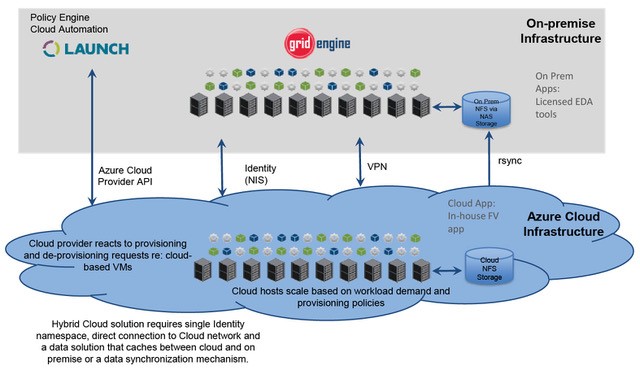No Waiting: Mellanox Uses Univa to Extend Silicon Design HPC Operation to Azure

Univa Grid Engine schema
Call it a corollary to Murphy’s Law: When a system is most in demand, when end users are most dependent on the system performing as required, when it’s crunch time – that’s when the system is most likely to blow up. Or make you wait in line to use it.
They know this at Mellanox as well as anyone. With nearly 3,000 employees worldwide, the supplier of Ethernet and InfiniBand interconnects for servers, storage, and hyper-converged infrastructure (used in half of the top 500 supercomputers) is under ongoing pressure to innovate a product line that includes high performance network and multicore processors, network adapters, switches, cables, software and silicon.
For the hundreds of developers supporting the company’s silicon design-related work, crunch time can overtax the Mellanox on-prem data center. The company needed a stable engineering HPC capability that could perform well in the on-premises high performance computing environment and burst transparently into Microsoft Azure Cloud during tape-outs – i.e., peak load periods.
“The idea is that we have a grid of servers that provide the compute calculations,” Doron Sayag, IT enterprise computing services senior manager, told EnterpriseTech. “And we’d like that the engineer has as simple an environment as possible, one in which he can submit a job request for his calculation according to the specific tool he’s working with, and he doesn’t care if the job runs on server number 1 or 2, he just wants it to run as fast as possible and get the results back. This is the main reason we use the job scheduler.”
 The Mellanox HPC cluster runs electronic design automation (EDA) pipeline software and simulation. The silicon engineering operation, which utilizes in-house tools and commercial applications, is computationally intensive. Sayag said superior workload orchestration is critical. For several years, the organization used Sun Grid Engine (SGE), an open source scheduler, but it lacked certain features and capabilities that Sayag and his colleagues felt were necessary.
The Mellanox HPC cluster runs electronic design automation (EDA) pipeline software and simulation. The silicon engineering operation, which utilizes in-house tools and commercial applications, is computationally intensive. Sayag said superior workload orchestration is critical. For several years, the organization used Sun Grid Engine (SGE), an open source scheduler, but it lacked certain features and capabilities that Sayag and his colleagues felt were necessary.
“We were running an open source job scheduler, but it presented stability issues,” he said. “We wanted to replace it with a robust enterprise-supported solution that was cloud-enabled. Also, we were looking for ways to add not just more features for product development but also to increase the productivity of the system we have. That’s what drove us to explore other options on the market.”
In the fall of last year, the silicon design group decided to switch from SGE to a solution from Univa, comprised of Navops Launch, Univa Grid Engine and Unisight, with features such as resource management, quotas and limits, and priority and utilization policies, all working to enable Mellanox’s existing on-premise infrastructure and workflows to encompass the cloud.
Along with cloud bursting, the applications provide a window into what the silicon operation is doing and the burdens placed on its on- and off-prem systems resources.
“I get statistics on the jobs running with the Unisight feature,” Sayag said. “We get a GUI and we get graphs according to our spec job types, we get information like run times, number of failures and so on, an overview of what we’re doing and where we have bottlenecks. Then we can prioritize tasks to fix them.”
He cited the example of scheduling compilation jobs. “Then we see that the compilations are taking a lot of time,” he said, “so engineers writing the compilation configuration can make them more efficient, reducing the run times. Then we see the results in Unisight,” confirming improved efficiencies.
 He said Navops Launch helps the silicon operation increase its on-premises data center efficiencies while addressing unmet peak performance needs with a cloud bursting ‘pay-as-you-go’ scenario – which enables the team to run as many jobs as required. It all happens quite transparently, Sayag said, so that developers aren’t aware when busting happens. With compute resource wait times virtually eliminated, Mellanox estimates that the Univa solution saves one third of the time of a skilled FTE.
He said Navops Launch helps the silicon operation increase its on-premises data center efficiencies while addressing unmet peak performance needs with a cloud bursting ‘pay-as-you-go’ scenario – which enables the team to run as many jobs as required. It all happens quite transparently, Sayag said, so that developers aren’t aware when busting happens. With compute resource wait times virtually eliminated, Mellanox estimates that the Univa solution saves one third of the time of a skilled FTE.
“By extending Univa Grid Engine to the Microsoft Azure Cloud, we gained practically infinite capacity from our hybrid cloud solution in a very cost-effective manner. The impact to our engineering teams is noticeable in terms of throughput and turnaround time, even though use of the cloud is completely transparent to them.”
Univa CEO Gary Tyreman said that while its hybrid HPC cloud orchestration software is broadly adopted in the life sciences, biotech and pharmaceuticals verticals, Mellanox is a pioneer among EDA semiconductor companies, most of which are “very sensitive to intellectual property exposure concerns,” he said. “The surprise I think to us is for a semiconductor company and a technology company to be embracing HPC in the cloud.”












